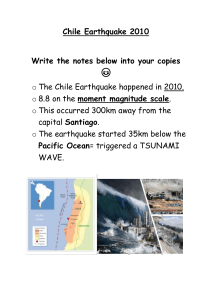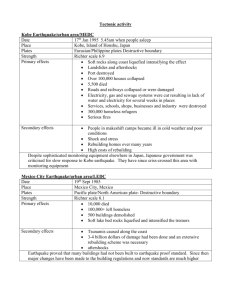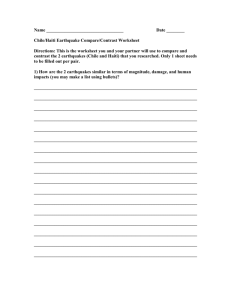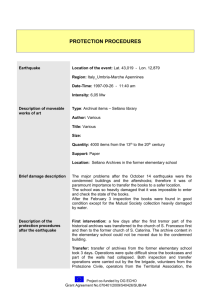“Just After the Earthquake” Working Group Presentation
advertisement
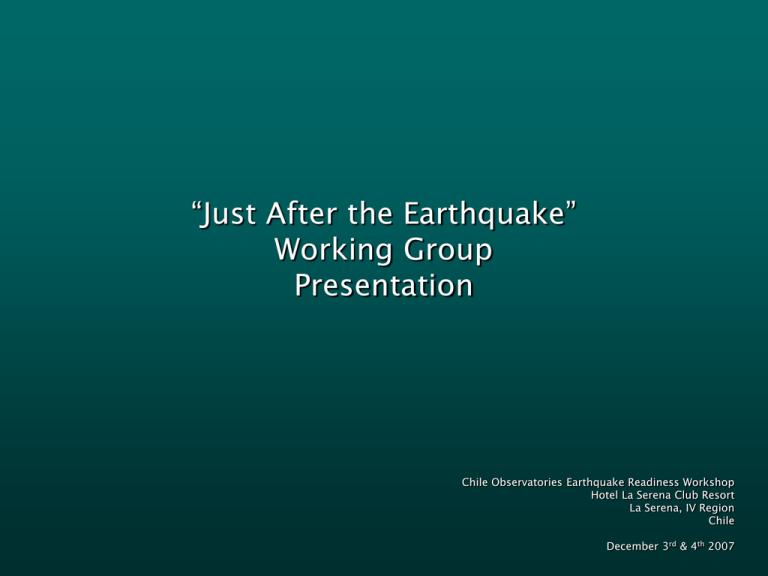
“Just After the Earthquake” Working Group Presentation Chile Observatories Earthquake Readiness Workshop Hotel La Serena Club Resort La Serena, IV Region Chile December 3rd & 4th 2007 “Just After” Issues Plan – Train – Act. How well people have planned and trained + how well people have reacted in the immediate aftermath set the scene for this stage of the response The grade of response should be appropriate to the grade or magnitude of the event Benchmarking and comparing operational notes are excellent initiatives, but it is critically important to create plans that are based firmly in the reality of your Observatory’s specific operational circumstances e.g. closeness of work sites to family members of staff; development stage of the organization; size of the organization; daytime, nighttime, weekend operations etc We have assumed we’re dealing with a major/high risk event We have defined “just after” as the period from when the shaking stops (at least of the building, if not our own!) to the stage when intermediate response steps are beginning to get underway We should adopt the same emergency response concepts when dealing with non-seismic disasters e.g. fire “Just After” Issues “Define” the event – value of seismic monitoring and displays; in the absence of such, consider the worst case scenario to begin with “Who is in charge?” – decision criteria for choosing response leaders; the importance of leadership + planning (neither on its own is sufficient); consider a team focus, substitutes where necessary, concentrate on leadership characteristics/preferred outcomes rather on formal leadership roles; create a flexible/adaptive decision-making structures SITUATION ASSESSMENT #1 : People focused – Count them, Who? Where? Dead? Injured? Missing? Panicking? Not available? Technical Focus – Direct, simple observations where possible (pick up the phone for a dial tone, radio with batteries, TV, web etc Note that in some ways in doesn’t matter how earnest your people focused efforts or your technical focused efforts are, if you don’t employ a communications focus. Without one, your efforts will be frustrated “Just After” Issues Launch only the most critical actions after the first situation assessment e.g. gas, electricity, fuel spills, major structural issues, most fundamental telescope checks Work to a “response skills” inventory/check list Work to a “resources required” inventory/check list Do what you can.....with what you’ve got........NOW The more practically based and intelligent pre-planning will help by by helping people work on “auto-pilot” (drill based) in high stress situation SITUATION ASSESSMENT # 2 then ACTIONS # 2 SITUATION ASSESSMENT # 3 then ACTIONS # 3 and so on.......... “ONLY BITE OFF WHAT YOU CAN CHEW” – IMPORTANCE OF PRACTICAL BASED ACTIONS & CONTINUOUS REVIEW (the graph below depicts only one type of response, of many possible responses) SOPHISTICATION / DEPTH OF ANALYSIS EVALUATE EVALUATE EVALUATE EVALUATE EVALUATE EVALUATE TECHNICAL ISSUES ACT ACT ACT ACT ACT ACT ACT PEOPLE ISSUES REPORT REPORT REPORT REPORT REMEMBER THAT AFTERSHOCKS MIGHT THROW YOUR PLANS OFF – SO PLAN FOR AFTERSHOCKS REPORT REPOR TIME
